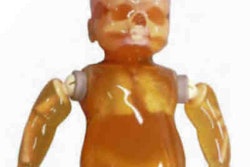
Lung ultrasound (LUS) scans outperformed chest x-rays for diagnosing neonatal pneumothorax in a new review that included more than 500 newborns. Ultrasound achieved better sensitivity and specificity and took less time to perform, according to the December 16 study in Ultrasound in Medicine & Biology.
Pneumothorax is a common but life-threatening illness seen in neonatal intensive care units. While CT is the gold standard for diagnosing pneumothorax in adults, chest x-ray is the preferred modality for newborns in order to reduce exposure to ionizing radiation.
Still, chest x-ray has its limitations for neonates. Newborns are especially at risk for latent effects from repeated exposure to ionizing radiation, and it can be difficult to detect pneumothorax with chest x-ray.
Instead, lung ultrasound may be the better first-line imaging modality for diagnosing pneumothorax in infants. Not only does ultrasound not expose infants to ionizing radiation -- it also appears to be more accurate.
"LUS is a new choice for the diagnosis and treatment of neonatal [pneumothorax]," wrote the authors, led by Qiang Fei, PhD, a professor at Zhejiang University School of Medicine in Hangzhou, China. "Compared with [chest x-ray], ultrasound combines the advantages of bedside diagnosis, avoidance of irradiation, cost-effectiveness, high accuracy, and reliability."
For the review, Fei and colleagues reviewed both Chinese- and English-language databases to find prospective studies investigating the diagnostic performance of chest x-ray and lung ultrasound for neonatal pneumothorax. Eight studies with a total of 529 infants met their inclusion criteria.
Lung ultrasound performed better than chest x-ray in the review. Ultrasound netted a sensitivity of 98% and specificity 99%, compared to 82% and 96% for chest radiography. Furthermore, ultrasound achieved an area under the curve of 0.997 and was faster to perform in five out of the eight studies.
The authors also calculated the diagnostic odds ratio (DOR) for both modalities -- a measurement of the effectiveness of a diagnostic test where higher numbers represent more effectiveness. Lung ultrasound achieved a DOR of 920, while chest radiographs had a DOR of 45.
| Chest x-ray vs. lung ultrasound for neonatal pneumothorax | ||
| Chest x-ray | Lung ultrasound | |
| Sensitivity | 82% | 98% |
| Specificity | 96% | 99% |
| Diagnostic odds ratio (DOR) | 45 | 920 |
"[Chest x-ray] is associated with a certain rate of misdiagnosis and is less sensitive than LUS for the diagnosis of mild-to-moderate [pneumothorax], especially in premature infants," Fei and colleagues wrote.
They theorized that chest x-ray may have limited usefulness in this population because the lesions are small and can be deep in the lungs. Meanwhile, ultrasound may be better suited to imaging the thin chest walls and narrow thorax of newborns.
The authors didn't have enough studies to sufficiently evaluate the accuracy of lung ultrasound features for diagnosing pneumothorax. However, the disappearance of lung sliding and B-lines and the presence of A-lines looked promising as diagnostic markers of the illness. In addition, the presence or absence of lung points -- where the visceral and parietal pleural surfaces meet -- looked useful for helping to determine illness severity.
Based on the findings, the researchers recommended lung ultrasound as a first-line modality for diagnosing pneumothorax in this population.
"[Chest x-ray] could be carried out as the second-line procedure if there are doubts about the findings during LUS examination, such as examination of neonates with large-area atelectasis," they wrote.



















